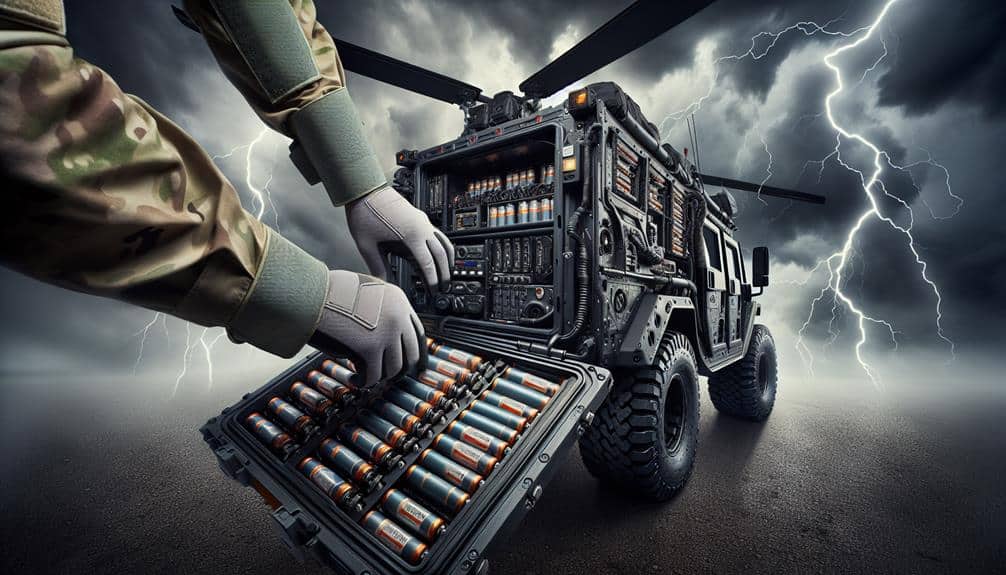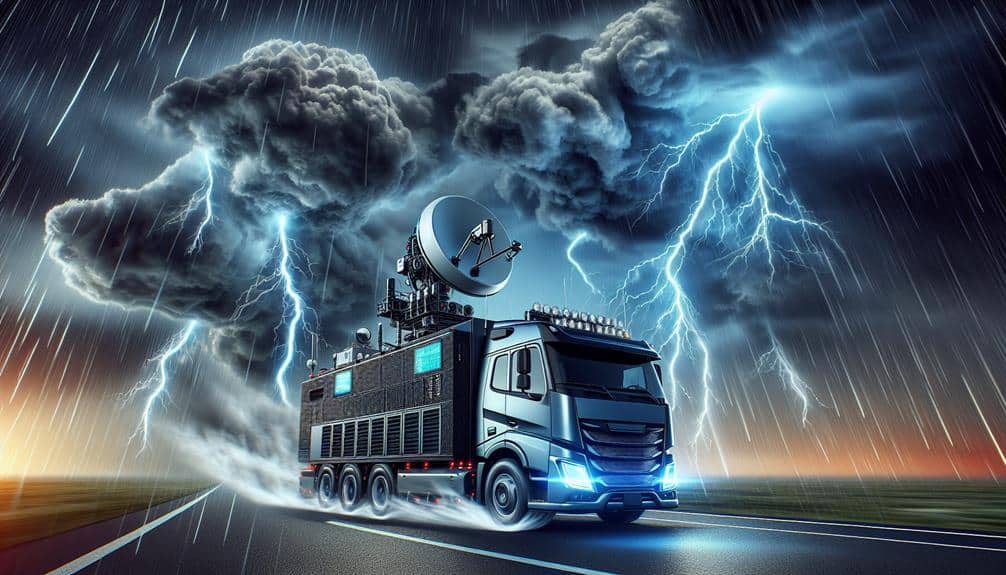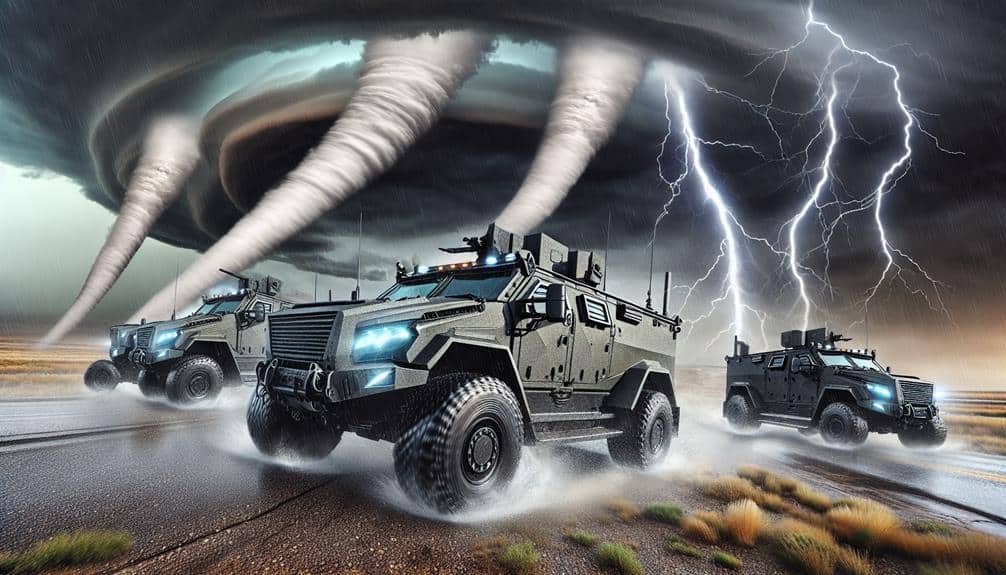To maximize storm chasing, we need durable rechargeable batteries that guarantee uninterrupted data collection and longevity critical for accurate storm analysis. It's crucial to choose high-capacity, weather-resistant batteries like those from Duracell, Energizer, and Panasonic that can withstand extreme conditions. Proper maintenance—like following recommended charging cycles and storing batteries in a climate-controlled environment—prolongs life and effectiveness. Monitoring battery levels and having reliable backups can prevent equipment failure. Our choices impact safety and performance, so selecting the best gear and maintaining it diligently greatly enhances our storm chasing outcomes. Discover more about optimizing battery use and ensuring safety further.
Key Points
- Choose high-capacity lithium-ion batteries for extended operation and reliable power during storm chasing.
- Opt for weather-resistant batteries like Energizer's Ultimate Lithium to ensure functionality in extreme temperatures.
- Regularly monitor battery levels and carry extra charged batteries and portable power banks.
- Follow proper charging habits and manufacturer guidelines to maintain battery health and performance.
Importance of Reliable Batteries
Understanding the importance of reliable batteries is crucial for maintaining uninterrupted data collection during storm chasing missions. When we're out in the field, the longevity advantages of dependable, high-capacity batteries become immediately obvious. Reliable batteries allow us to gather continuous data on storm patterns, wind speeds, and other essential variables without the risk of sudden power loss. This uninterrupted data stream is vital for accurate storm analysis and forecasting.
Moreover, reliable batteries play a significant role in our emergency preparedness. In high-stress situations where immediate decisions can make a difference between safety and danger, having a trustworthy power source is non-negotiable. Reliable batteries guarantee that our communication devices, GPS units, and weather instruments remain operational throughout the mission. This operational consistency is necessary for maintaining situational awareness and coordinating with team members in real-time.
Data-driven evidence supports that batteries with proven longevity benefits notably reduce the risk of equipment failure. This reliability allows us to focus on the critical task at hand—monitoring and understanding extreme weather phenomena—without the distraction of potential technical setbacks.
Essentially, investing in high-quality, durable rechargeable batteries is a strategic move that enhances both our data collection capabilities and our overall safety in the field.
Key Features to Consider
Given the essential role of reliable batteries in storm chasing, let's examine the key features that make certain batteries stand out for this demanding application.
First, battery durability is critical. We need batteries that can withstand the rigors of extreme weather conditions and frequent use. Durability guarantees that our equipment remains operational when it matters most, without unexpected failures.
Next, charging capacity is a crucial consideration. High-capacity batteries allow us to operate our devices for extended periods without needing frequent recharges. This feature is particularly important during prolonged storm-chasing sessions when access to power sources may be limited.
Energy efficiency is another significant factor. Efficient batteries maximize the amount of usable power extracted from each charge, reducing waste and extending operational time. This efficiency translates to fewer battery swaps and more continuous monitoring of storm patterns.
Lastly, weather resistance can't be underestimated. Batteries designed with robust weather-resistant features can endure harsh conditions such as heavy rain, high winds, and extreme temperatures. This resilience guarantees that our equipment remains functional in diverse and challenging environments.
Battery Life Expectations
When evaluating battery life, we need to analyze both estimated usage duration and power consumption rates.
By examining these factors, we can predict how long our equipment will function in the field.
Accurate data on power usage helps us choose the most reliable batteries for storm chasing.
Estimated Usage Duration
To effectively plan our storm chasing adventures, we need to take into account the estimated usage duration of our rechargeable batteries, ensuring that they provide reliable power throughout the entire event. Understanding our charging habits is vital. We should fully charge our batteries before setting out and know how long it takes to reach full capacity. This allows us to synchronize our charging schedules with our storm chasing timelines, ensuring we maximize battery life.
Data indicates that high-capacity lithium-ion batteries typically last between 8 to 12 hours under moderate use. However, this can vary based on the devices we use and the conditions we face. It's crucial to monitor our battery levels regularly and have backup options ready.
Carrying extra sets of charged batteries and portable power banks can make a significant difference, especially during prolonged chases.
Power Consumption Rates
Understanding our batteries' power consumption rates is essential for predicting their performance during storm chasing activities. By examining the energy efficiency and power management of our equipment, we can guarantee longer operational times and more successful chases.
To achieve this, we must consider several factors that influence battery life.
- Device Specifications: Different devices draw varying amounts of power, impacting how long our batteries will last. High-energy-demand devices like radar systems and high-resolution cameras consume more power compared to GPS units or handheld radios.
- Operational Conditions: Extreme temperatures can affect battery performance. Cold weather can reduce battery efficiency, while high temperatures can accelerate discharge rates.
Top Battery Brands
When considering top battery brands, we need to evaluate their performance and longevity, as well as their reliability in extreme conditions.
Data shows that brands like Duracell, Panasonic, and Energizer consistently provide high energy density and robust cycle life.
Reliable performance in harsh weather is essential for storm chasing, making these brands indispensable for our ventures.
Performance and Longevity
Leading the market in performance and longevity, top battery brands like Duracell, Energizer, and Panasonic consistently deliver reliable power for storm chasing enthusiasts. These brands are renowned for their long term durability and enhanced performance, ensuring our gear remains operational when we need it most.
Each brand offers unique advantages that make them ideal choices for storm chasers:
- Duracell: Known for its long-lasting power, Duracell batteries are engineered for long term durability, making them a staple in our storm chasing kits.
- Energizer: With a focus on enhanced performance, Energizer batteries provide consistent energy output, which is critical when tracking severe weather.
We need batteries that can endure the rigors of storm chasing, from the intense usage of high-powered cameras to the continuous operation of communication devices. Data from independent tests indicate that these brands maintain their charge longer and perform better under heavy loads compared to lesser-known alternatives.
Reliability in Extremes
Even under the harshest weather conditions, top battery brands like Duracell, Energizer, and Panasonic consistently demonstrate exceptional reliability. These brands have engineered their products to withstand extreme conditions, guaranteeing durability and consistent performance. For storm chasers, having reliable power sources is essential, and these batteries deliver, providing us with peace of mind.
Duracell's Procell line, for instance, boasts a performance range from -20°C to 54°C, ensuring that our equipment remains operational in both freezing and scorching temperatures. Energizer's Ultimate Lithium batteries, renowned for their endurance, are designed to function in temperatures as low as -40°C and as high as 60°C. Similarly, Panasonic's Eneloop Pro batteries maintain reliable power in extreme conditions, offering us the durability necessary for prolonged field operations.
Data from various field tests have shown that these brands retain up to 85% of their charge after one year of storage under harsh conditions, making them indispensable for unpredictable weather scenarios. By investing in these top-tier batteries, we safeguard that our devices remain powered, allowing us to focus on capturing critical data and smoothly handling the challenges of storm chasing effectively and safely.
Proper Battery Maintenance

Proper battery maintenance guarantees that your rechargeable batteries perform at their peak and have a longer lifespan. To enhance our storm chasing adventures, we need to focus on ideal charging habits and proper battery storage.
Always charge batteries according to manufacturer guidelines, as overcharging can degrade battery health. Store batteries in a cool, dry place to prevent any potential damage from extreme temperatures or humidity.
Regular battery testing is essential to ensure that our batteries are in top condition. Using a multimeter, we can check the voltage and capacity, ensuring they meet the necessary specifications. If a battery shows significant decline in performance, consider recycling options to dispose of it responsibly and make way for fresh batteries.
Key points for maintaining battery health include:
- Charging habits: Follow recommended charging cycles and avoid overcharging.
- Battery storage: Keep batteries in a climate-controlled environment.
Safety Tips for Batteries
While maintaining battery health is essential for performance, we must also prioritize safety to prevent accidents and guarantee reliable operation during our storm chasing expeditions.
First, let's address charging precautions. Always use the charger specified by the battery manufacturer to avoid overcharging or overheating. Overcharging can lead to thermal runaway, a dangerous condition. Additionally, refrain from charging batteries unattended, especially overnight.
Proper battery storage is another critical aspect. Store batteries in a cool, dry place away from direct sunlight and extreme temperatures. Extreme heat or cold can degrade battery life and increase the risk of leakage or rupture. For weatherproofing, ensure batteries are housed in waterproof containers to protect against moisture and debris during storms.
Emergency preparedness is key when dealing with rechargeable batteries. Carry a fire extinguisher rated for electrical fires and a first-aid kit. Familiarize yourself with the signs of battery failure, such as bulging or excessive heat, and know how to respond swiftly.
Frequently Asked Questions
How Do Weather Conditions Affect Battery Performance During Storm Chasing?
Did you know battery performance drops by 20% in cold weather? Weather impact is pivotal during storm chasing since extreme conditions can greatly affect our power supply, making reliable batteries essential for maintaining consistent energy levels.
Are There Portable Charging Options Available for Use in the Field?
Yes, there are portable charging options available for use in the field. We can utilize solar panels, power banks, wind turbines, and generators. These options guarantee we have reliable power regardless of weather conditions.
Can Rechargeable Batteries Power All Storm Chasing Equipment?
Just like a marathoner needs endurance, our rechargeable batteries must have a long battery lifespan and high charging efficiency. With these traits, they can indeed power all our storm chasing equipment, ensuring we capture every critical moment.
What Are the Signs a Rechargeable Battery Needs Replacement?
When we observe a shortened battery lifespan, reduced charging capacity, or visible signs of wear, it's clear the performance indicators suggest replacement timeframes are imminent. Reliable data helps us maintain freedom in our equipment's functionality.
How Should Batteries Be Stored When Not in Use for Storm Chasing?
To guarantee proper storage and battery maintenance, we should store batteries in a cool, dry place at around 40-60% charge. Regularly check their voltage and avoid extreme temperatures. This optimizes performance and extends battery life.

